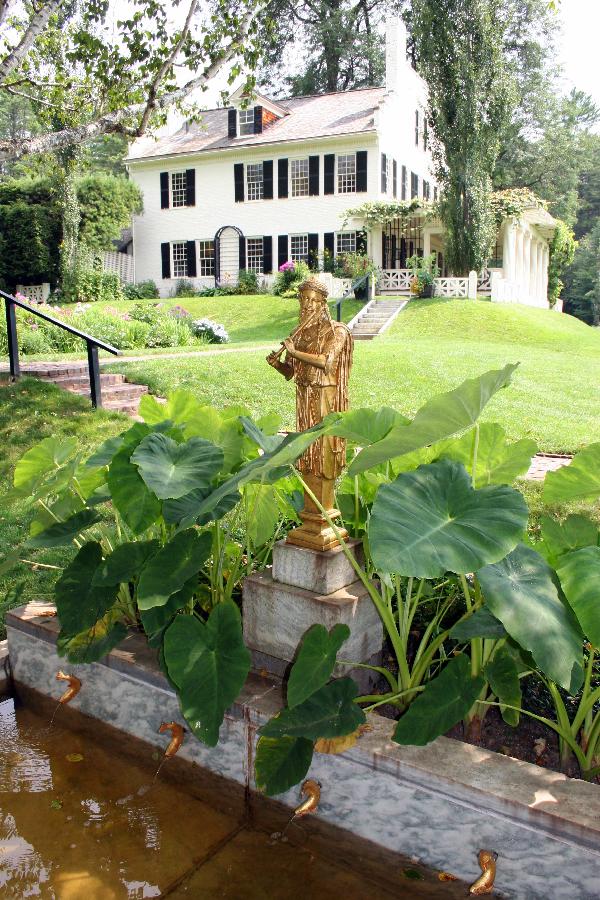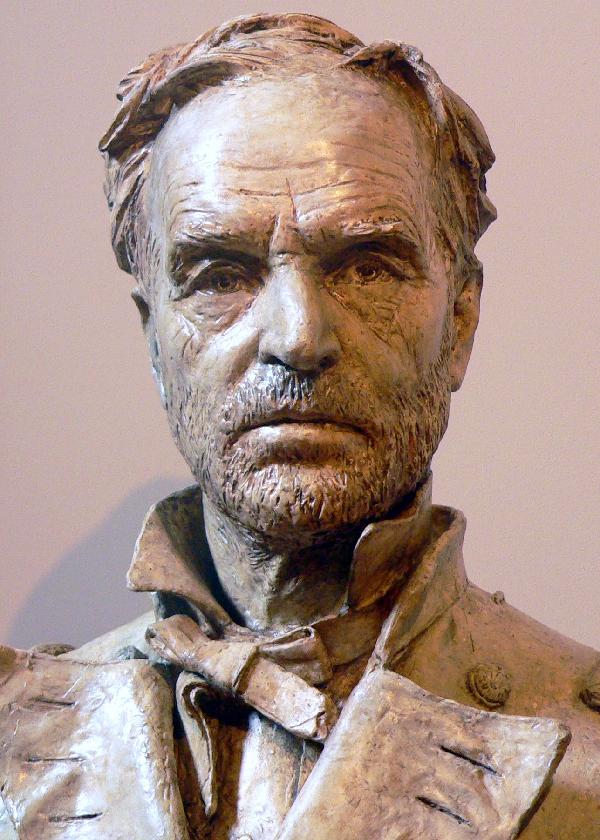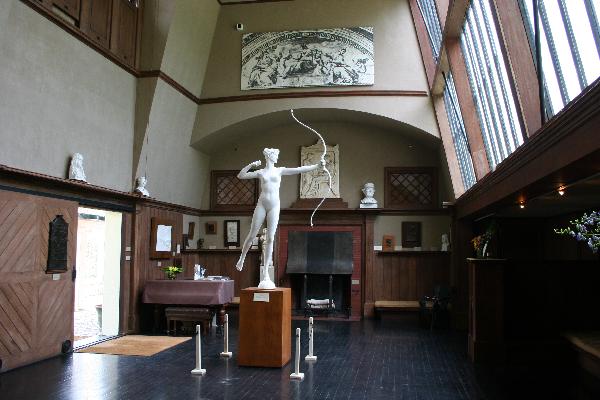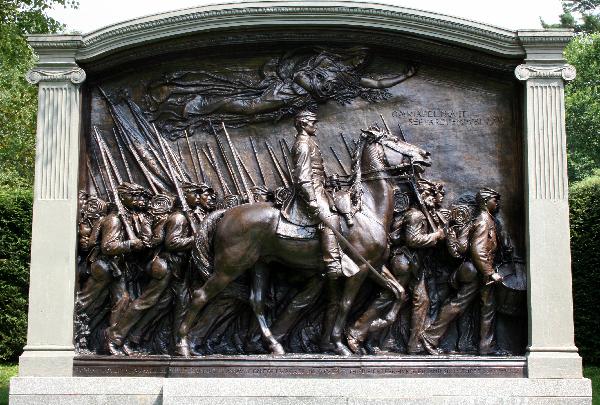Cornish, N.H.
NPS Website; Local Website

Sprawling estate and studio of one of America’s most celebrated sculptors, Augustus Saint-Gaudens (1848-1907).
BEAUTY (8/10)
Now this is what an artists' colony should look like. Dramatic views of the solitary and volcanic-shaped Mt. Ascutney, swaths of manicured green grass surrounded by a thick white pine forest, formal hedge gardens that showcase astounding sculptures, a half-dozen utlitarian detached buildings born again as studios and a stately white main house.
The grounds' endearing allure is its countless nooks and many offerings of solitude amidst man-made and natural beauty. The Site also houses casts of all Saint-Gaudens most famous sculptures. These works range from evocative complex portraits of historic heroes (statues of General Sherman, President Lincoln and the Shaw Memorial) to displays of mythologic elegance (Diana and Nike) to sublime understandings of the profound (the Adams Memorial).
Casts of these masterpieces are standouts in public space throughout the United States. New York's Central Park, Boston Common, DC's Rock Creek Park and Lincoln Park in Chicago. Saint-Gaudens NHS offers the wonderful opportunity to see all of these without amassing frequent flier miles.
HISTORICAL INTEREST (4/10)
Augustus Saint-Gaudens was just six months old when he and his French shoemaker father and Irish mother immigrated to the United States in 1848 from Dublin. Augustus' fathers chic French shoe store thrived in New York City and he was able to send his talented 19-year old son to the famed Beaux-Artes School in Paris, the preeminent art school of the era. While in Paris, Augustus insisted on the Americanized pronunciation of his name (SAINT-GAW-dens).

Saint-Gaudens first major public work was his monument to Civil War hero, Admiral David Farragut, unveiled in New York City's Madison Square in 1881. Farragut's heroic, gritty, non-classical portrayal initiated a wave of similarly themed work for Saint-Gaudens and other realist Civil War soldier commemerators. Augustus did much of his sculpting here in Cornish. His estate served as a popular magnet for writers, poets, painters and fellow sculptors.
Saint Gaudens' works have remained etched in our collective artistic conscience and he can fairly be compared to his famed sculpting contemporary Augustus Rodin.
CROWDS (6/10)
The day's rain, the Site's remoteness and Saint-Gaudens unjust obscurity could all be responsible for the Park's light vistitor turnout. But even if there were many guests, it would still be very easy to lose yourself amidst one of the artist's many works without anyone there to spoil your serenity.
EASE OF USE/ACCESS (2/5)
Saint-Gaudens NHS is located in west-central New Hampshire, a stone's throw from the White River and just across the border from Windsor, Vermont. The bridge that crosses from Windsor over to New Hampshire is covered. No lie. As you would imagine, the nearest large cities (Albany, Hartford and Boston) are all over 120 miles away.
Interstates 89 and 91 both drop you off about 15 miles from the Site. The most direct route would be I-89, Exit 20 and then south on New Hampshire Route 12A for 12 miles. The Site's entrance is on the eastern side of Route 12A.
Come in summer. Harsh New Hampshire winters close the site from October through late May.
CONCESSIONS/BOOKSTORE (4/5)
The Site's has a thin but compelling selection of books, including an entire stack of rare and/or out-of-print Saint-Gaudens books. Michael was tempted by Erik Larson's bestseller Devil in the White City in which Saint-Gaudens makes a cameo (pardon the pun). Has anybody out there read it?
We also liked the site-specific charmers that included fancy Diana brooches, make-your-first sculpture starter kits, maple syrup and replicas of Saint-Gaudens famous coin designs.

COSTS (3/5)
Entry is $5 per person, free with the National Parks Pass.
RANGER/GUIDE TO TOURIST RATIO (4/5)
The Site's Rangers, most of which were on the young side, tended to appear stealthfully and suddenly from the Park's many niches. We were grateful for the effusive guidance from the Ranger posted at the fee-station kiosk. He suggested a route through the Site and made us aware of the Ranger talks. Without his help, the large grounds could have been intimidating.
TOURS/CLASSES (6/10)
Every inch of the Site's grounds can fairly be called museum space; everywhere you look there are casts, sculptures, gardens, fountains and attractions. None of these exhibits, however, are accompanied by any self-directed panels or explanations.
No matter, Saint-Gaudens NHS says. That is why, during the summer, six Ranger-led tours are scheduled per day. In addition, the Site has a Sculptor-in-Residence stationed at the Ravine Studio and ready all day (except lunch-time) to answer your sculpture technique questions.
We took in an excellent 10-minute lecuture about the Farragut Memorial and continued on to the remaining sculptures by ourselves. Saint-Gaudens' works are intimate, powerful and deeply moving. Sometimes listening to the art is preferable to learning trivia and historical datum.
FUN (7/10)
We had a terrific day wandering from studio to studio appreciating the stunning surroundings, enjoying Saint-Gaudens' life and works. We even liked the rotating modern photography and sculpture exhbits although, judging from the comment book, we were the only ones. We were not there to enjoy the Park's Sunday afternoon summer classical music concerts but we would be hard pressed to come up with a more perfect setting.

WOULD WE RECOMMEND? (5/10)
Only to the hardcore art tourist. I mean, when was the last time you found yourself in Cornish, New Hampshire? You have probably seen and admired Saint-Gaudens sculptures and not even realized it. His work has a place in a few major East Coast cities.
If you are in New England and don't want to make the drive to New Hampshire, be sure to stop in Boston and admire the Shaw Memorial across from the Massachusetts State House. The Memorial commemorates the 54th Massachusetts Volunteer Regiment, the first official African-American unit in the United States Army. Their story was told in the 1989 Denzel Washington movie, Glory. You might remember Saint-Gaudens' work from the film; it was featured in the credits.
TOTAL 49/80
www.usa-c2c.com
© 2004-06